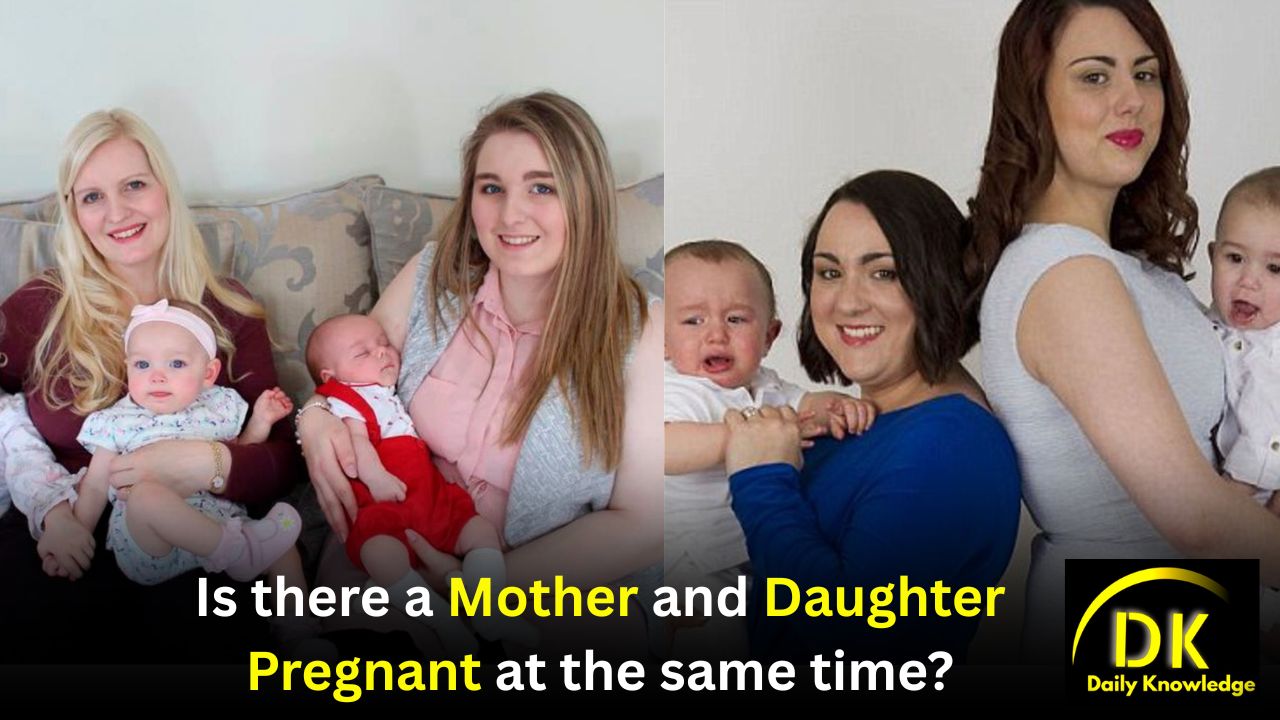Mothers and Daughters Pregnant Together: Exploring Intergenerational Pregnancy Experiences, Insights and Stories, A Look into Family Dynamics. Is there a mother and daughter Pregnant at the same time?
Mother and Daughter Pregnant at the Same Time: A Unique Bonding Experience

Pregnancy is often considered a transformative life event, filled with joy, anticipation, and challenges. But what happens when a mother and daughter experience this journey simultaneously? While rare, cases of mothers and daughters being pregnant at the same time have occurred across the globe, creating unique dynamics and fascinating stories. This blog explores the emotional, social, and health implications of such occurrences, along with real-life examples that highlight the phenomenon.
The Emotional Impact of Shared Pregnancy
Experiencing pregnancy alongside one’s mother or daughter can create an extraordinary bond. The shared milestones, such as ultrasounds, baby showers, and labor preparation, can deepen their relationship. For many women, pregnancy is a time of vulnerability and growth, and having someone close who truly understands the experience can be comforting.
For instance, Angela Patram and her daughter Teranisha Billups gave birth within an hour of each other at Tampa General Hospital. Their simultaneous pregnancies brought them closer as they navigated labor in adjacent rooms. Such experiences can foster mutual support and create lasting memories for both generations.
Real-Life Stories: When Mother and Daughter Are Pregnant Together
Here are some notable examples of mothers and daughters who were pregnant at the same time:
- Angela Patram and Teranisha Billups:
This mother-daughter duo delivered their babies within an hour of each other. Angela gave birth to her fifth child while her daughter welcomed her first child via C-section just 34 minutes later. Their story highlights how shared pregnancies can become a unique bonding experience.
- Mildred Mashego and Patricia Mashego:
In South Africa, Mildred (38) and her daughter Patricia (19) were both pregnant by the same man. They gave birth just four days apart. While their situation was complicated by family dynamics and societal stigma, the birth of healthy boys ultimately brought reconciliation within the family.
- Lisa Rutherford and Kelsi Pierce:
Lisa Rutherford acted as a surrogate for her daughter Kelsi Pierce after Kelsi struggled with infertility for years. Just a month after Lisa’s embryo transfer, Kelsi herself became pregnant naturally. Their shared pregnancy journey resulted in two sisters born just weeks apart — a testament to resilience and familial love.
Health Considerations for Simultaneous Pregnancies
When a mother and daughter are pregnant at the same time, their pregnancies may differ due to age-related factors:
- Older Mothers:
Women over 35 face higher risks during pregnancy, including gestational diabetes,preeclampsia, or complications related to multiple pregnancies. Mothers who are older may require closer monitoring.
- Young Mothers:
Younger women may experience fewer health risks but could face emotional challenges or societal stigma if they are unmarried or unprepared for motherhood.
In cases where both women are pregnant simultaneously, healthcare providers must address their individual needs while fostering mutual support.
Social Dynamics: Challenges and Opportunities
Simultaneous pregnancies can lead to complex social dynamics within families:
- Family Support:
Shared pregnancies often result in increased family involvement. Grandparents-to-be may find themselves preparing for two new additions simultaneously.
- Conflict Resolution:
In cases like Mildred and Patricia Mashego’s story, shared pregnancies can reveal underlying family tensions but also provide opportunities for reconciliation.
- Community Perception:
Societal attitudes toward simultaneous pregnancies vary based on cultural norms. In some communities, this phenomenon might be celebrated; in others, it could be stigmatized.
The Psychological Bond Between Generations
Shared pregnancies often strengthen the psychological bond between mothers and daughters. According to research on mother-daughter relationships in underserved communities, mutual support during life transitions like pregnancy can empower both parties. Daughters may even act as advocates for their mothers’ health needs during this time.
This intergenerational connection fosters emotional resilience and creates a shared sense of purpose as both prepare to welcome new lives into the world.
What are the chances of a mother and daughter getting pregnant at the same time?
The chances of a mother and daughter getting pregnant at the same time are extremely rare, but it is possible. Several factors can influence this occurrence:
- Age:
As women in their 30s and 40s have higher levels of estrogen, they are more likely to release multiple eggs during ovulation, increasing the chances of pregnancy. If a mother is in her late 30s or early 40s while her daughter is of reproductive age, their fertility windows could overlap.
- Heredity:
Women who are fraternal twins, have had fraternal twins, or have siblings who are fraternal twins are more likely to conceive twins themselves. This genetic predisposition could potentially affect both mother and daughter.
- Assisted reproductive techniques:
If either the mother or daughter is undergoing fertility treatments, their chances of pregnancy may increase. This could potentially lead to simultaneous pregnancies if both are trying to conceive.
- Timing:
For this rare event to occur, both mother and daughter would need to be sexually active and ovulating around the same time.
It’s important to note that while simultaneous pregnancies in a mother-daughter pair are possible, they are extremely uncommon. The likelihood is further reduced by factors such as the typical age gap between mothers and daughters of reproductive age, and the natural decline in fertility as women get older.
Additionally, it’s worth mentioning that superfetation (becoming pregnant while already pregnant) is an extremely rare event, with the chances being near zero. This further emphasizes the rarity of simultaneous mother-daughter pregnancies.
Conclusion
While rare, instances of mothers and daughters being pregnant at the same time offer fascinating insights into family dynamics, health considerations, and emotional bonds. From heartwarming stories like Angela Patram’s simultaneous delivery with her daughter to more complex situations involving shared fathers or surrogacy journeys like Lisa Rutherford’s case — these events showcase the diversity of human experiences.
Ultimately, simultaneous pregnancies reflect not only biological coincidences but also profound emotional connections that transcend generations. Whether celebrated or complicated by societal norms, these unique journeys remind us of the enduring power of family bonds during life’s most transformative moments.

